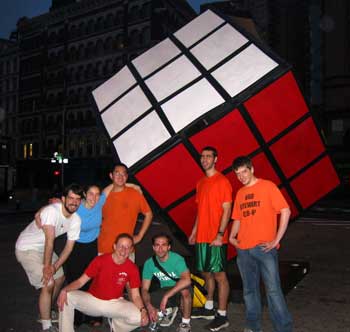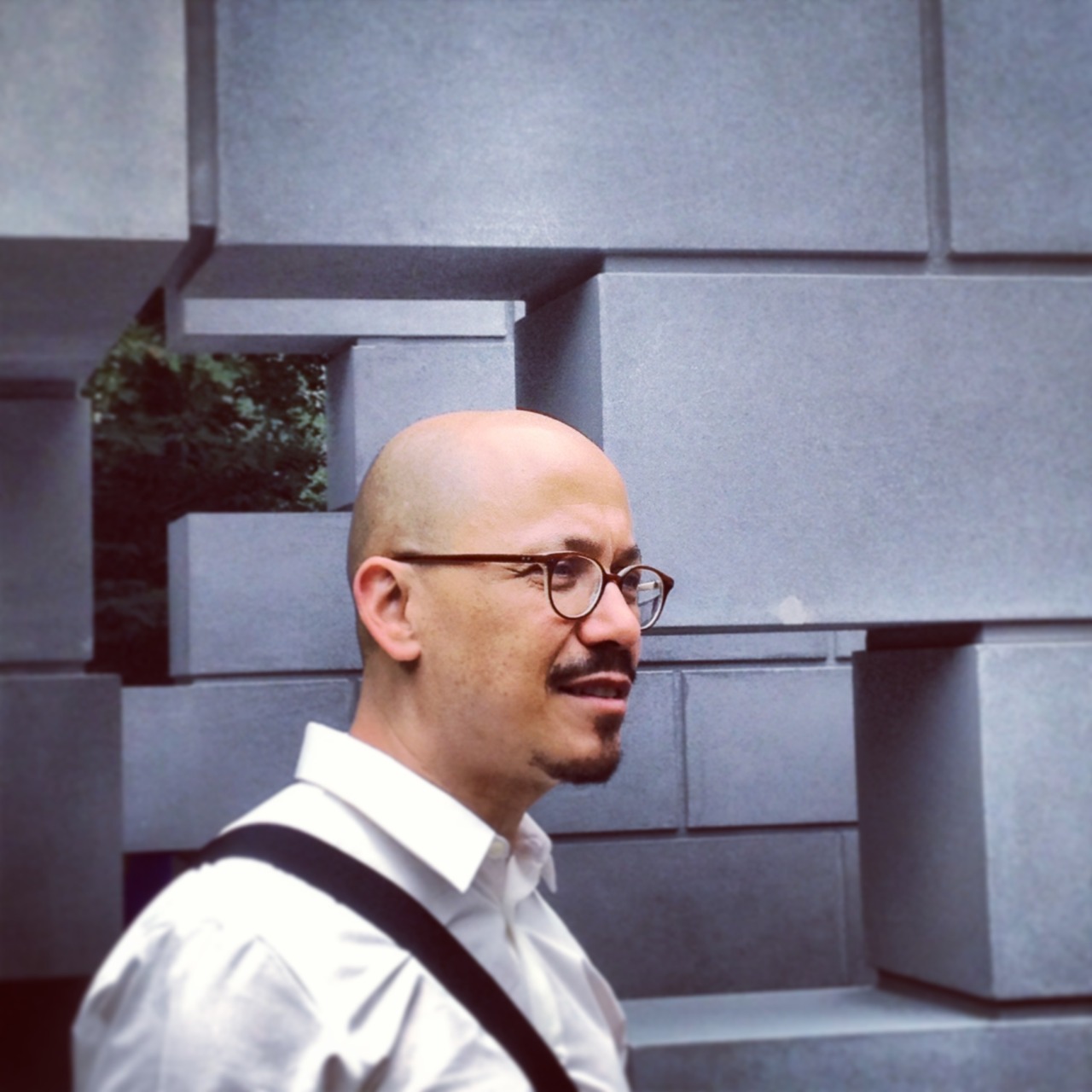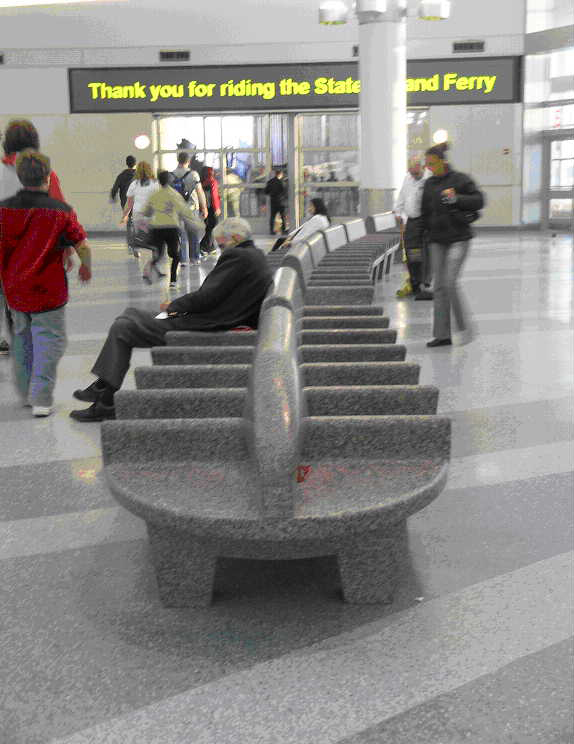 “The Alamo” Sculpture, more commonly recognized by New Yorkers as the Astor Cube, is an interesting and popular site-specific work of public art. The Cube was created by American artist Tony Rosenthal in 1967. Its location is near Cooper Square and Lafayette Street in Astor Place, which is a short two block street in Lower Manhattan. Starbucks, K-Mart, as well as a few libraries, a movie theatre, and several shops surround the landmark, because of its situated location being in a usually busy intersection. Nearby are subway stations, which makes the Cube accessible from the 4,6,N, and R trains. Its name is derived from the Alamo Mission in San Antonio, Texas, given to it by the artist’s wife, as stated by a plaque on the structure. The Cube seems to be standing on one corner and therefore can be ‘spun’ around by one or many people.
“The Alamo” Sculpture, more commonly recognized by New Yorkers as the Astor Cube, is an interesting and popular site-specific work of public art. The Cube was created by American artist Tony Rosenthal in 1967. Its location is near Cooper Square and Lafayette Street in Astor Place, which is a short two block street in Lower Manhattan. Starbucks, K-Mart, as well as a few libraries, a movie theatre, and several shops surround the landmark, because of its situated location being in a usually busy intersection. Nearby are subway stations, which makes the Cube accessible from the 4,6,N, and R trains. Its name is derived from the Alamo Mission in San Antonio, Texas, given to it by the artist’s wife, as stated by a plaque on the structure. The Cube seems to be standing on one corner and therefore can be ‘spun’ around by one or many people.
Tony Rosenthal was born in the year 1914 as Bernard J. Rosenthal in Highland Park, a suburb of Chicago Illinois. Rosenthal attended sculpture classes at the Art Institute of Chicago in the early ’30s until he moved to Ann Arbor, Michigan, where he graduated with a Bachelor of Arts Degree at the University of MIchigan in 1936. Studying with him were renowned avant-garde artists and sculptors Alexander Archipenko and Carl Milles. From a young age, Tony Rosenthal was very fascinated with many art forms, including cubism and abstract art. These experiences would later inspire him to become a part of the American abstract expressionism movement. After serving in World War II, Tony took up a career in teaching at the American University in Washington, DC and later at the University of California.

Going back to “The Alamo”, it is important to note that this Cube was his most influential work since it established him as a “master of monumental public sculpture and standard bearer of contemporary structurist esthetic”, according to many historians. The artist, in his own words, stated that: “It is… important to me (Tony Rosenthal) that the sculpture interact with the people”. And that is exactly what it did. For decades, “The Alamo” has been frequented as a hangout spot for many groups of New Yorkers, mainly among the skater and hipster subgroups, as well as a meeting place for the “East Village kids” and St. Mark’s residents. People could be regularly seen either sitting or standing next to the Cube and teenagers would “play” with the Cube since it is able to spin on its axis all the way around. So it has been established that the Cube was actually designed to do this to give it a more playful and warm, child-like atmosphere in contrast to the hustle and bustle and seriousness of the big city. The Cube has also become an attraction for tourists visiting the city, who would take photos of and spin the Cube as well.
The Cube gives many people different reactions or perspectives on its purpose or underlying meaning. Some perceive it as a symbol representing immense strength because of its rather large size (8 by 8 by 8 feet) and perceived weight due to being made of Cor-Ten steel (approx. 1,800 pounds). Others see it as an ‘escape from reality’; in other words, it is speculated that the Cube, which stands out proudly and greatly as a large black figure in the bland background of simple buildings and trees, may be interpreted as a way to help relieve the stress of everyday life. Some say the Cube gives off a certain relaxed, positive energy which seems to attract people towards it. Being situated in a busy area gives some sense of wonder, enjoyment, and mystery to some of the working stiffs. It makes you stop and think. My view on the Cube is that I believe it is meant to act as sort of a ‘puzzle ‘ that wants to be solved but can’t be because it lacks the necessary pieces to be solved, such as some of the puzzles that we encounter in our own lives. The Cube contains protrusions and indentations which further relate to this theory. I can see that certain connection as a possible interpretation. Maybe it’s not even meant to have a meaning or purpose at all, maybe it’s just a display- a work of art made for others to indulge in and appreciate.
The Cube, in my opinion, successfully uses its space well in the area in which it is situated. People come with their friends to show its beauty and to take the time to interact with it. As I have said before, it makes for a great place for just sitting around and hanging out. The Astor Cube is a work of art which deserves to be displayed to the public, and what better place than the busy streets of Manhattan, where many can see it.
The Astor Cube was just one of five other cubes that Rosenthal had made, but it quickly became the most popular over time, nonetheless, more so than his other works, such as “Marty’s Cube” and “House of the Minotaur”. Even more so, this public work of art has arguably become the artist’s most popular work to date and will always be in his memory, since Rosenthal passed away at age 94 in 2009. It is hard truly hard to believe that this masterpiece was only meant to be a temporary 6 month exhibition at first, and then they were supposed to take it down. Thankfully, residents made petitions to keep the Cube.

Some intriguing controversies surrounding the Cube involve a series of pranks which have taken place in the past years. For example, in 2003 a group dubbed “The ATF Squad” turned the Astor Cube into a giant Rubik’s Cube using painted cardboard panels.Two more instances of pranking took place in 2011, where a visual artist covered the Cube with her signature camouflage and later a group of Caltech Students made the Cube resemble the Weighted Companion Cube from the video game Portal. Because of this, the Cube goes through a lot of maintenance. There was recently a short documentary entitled “Man In A Cube” in which a 37-year-old writer claimed to have been living inside the Astor Cube because he: “was searching for solitude” and escape from “constant bombardment of social technology, email, and modern distractions” according to an article on apartmenttherapy.com. This was soon discovered to have been a hoax, though. The story was all part of an ad campaign for an organization named Whil with the intention of promoting meditation. The link for the short documentary can be found below:
http://www.youtube.com/watch?feature=player_embedded&v=Wcl9NPl481k
In conclusion, it can safely be said that “The Alamo” aka The Astor Cube is a very important work of public “site-specific” art because it successfully attempts to integrate with its surroundings and outdoor locale. It is definitely a sight to see and people are free to interact with and interpret it however they see fit. That is what art should be.






















 IRAN DO ESPÍRITO SANTO was born in Mococa, Brazil, in 1963, and is one of Brazil’s most highly regarded contemporary artists. Today, Santo lives and works in São Paulo, Brazil. He is well known for his austere and opulent drawings, wall paintings, and sculptors. Often working on an elaborate scale, Santo supports the Minimalist doctrine of non-objectivity through his large, abstract sculptures of everyday objects that he disorients the size and idea of through his use of surrealism. If one were to give him, say, a circular mirror, he would reflect on the object’s properties of material and shape. Then, he would transform the once mundane object into something sensual, yet Minimalistic at the same time. Santo’s background in photography is clearly apparent in the way he constructs his works as a photographer constructs her images. Also setting him apart is his preference to use incongruous materials, such as copper, glass, granite and stone for his pieces. Santo’s sculptures tend to strip away the irrelevant details of objects, leaving the essential line and forms of the things highly emphasized. In all of his works, Santo implements illusionistic devices to add to the object’s noteworthiness.
IRAN DO ESPÍRITO SANTO was born in Mococa, Brazil, in 1963, and is one of Brazil’s most highly regarded contemporary artists. Today, Santo lives and works in São Paulo, Brazil. He is well known for his austere and opulent drawings, wall paintings, and sculptors. Often working on an elaborate scale, Santo supports the Minimalist doctrine of non-objectivity through his large, abstract sculptures of everyday objects that he disorients the size and idea of through his use of surrealism. If one were to give him, say, a circular mirror, he would reflect on the object’s properties of material and shape. Then, he would transform the once mundane object into something sensual, yet Minimalistic at the same time. Santo’s background in photography is clearly apparent in the way he constructs his works as a photographer constructs her images. Also setting him apart is his preference to use incongruous materials, such as copper, glass, granite and stone for his pieces. Santo’s sculptures tend to strip away the irrelevant details of objects, leaving the essential line and forms of the things highly emphasized. In all of his works, Santo implements illusionistic devices to add to the object’s noteworthiness.







